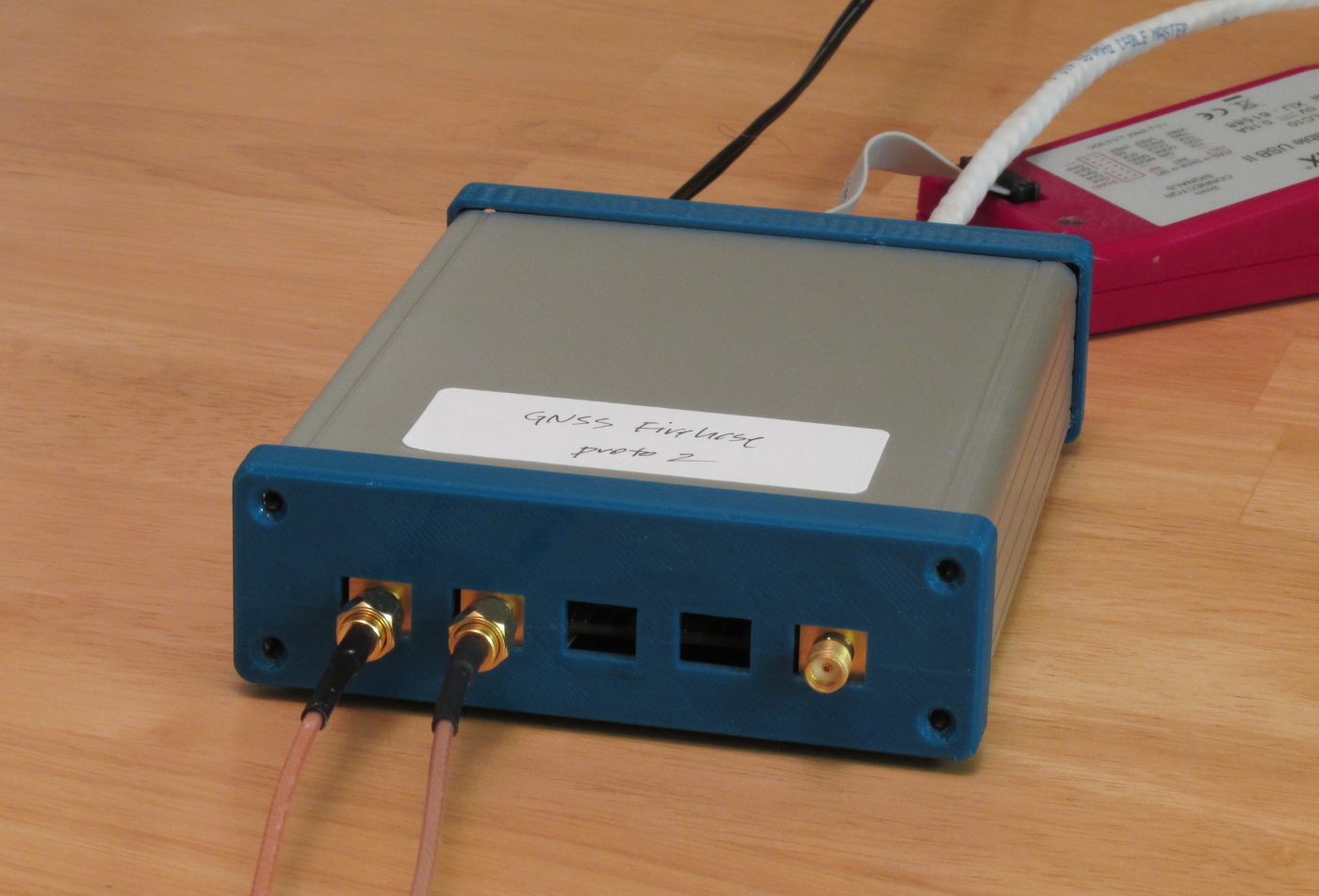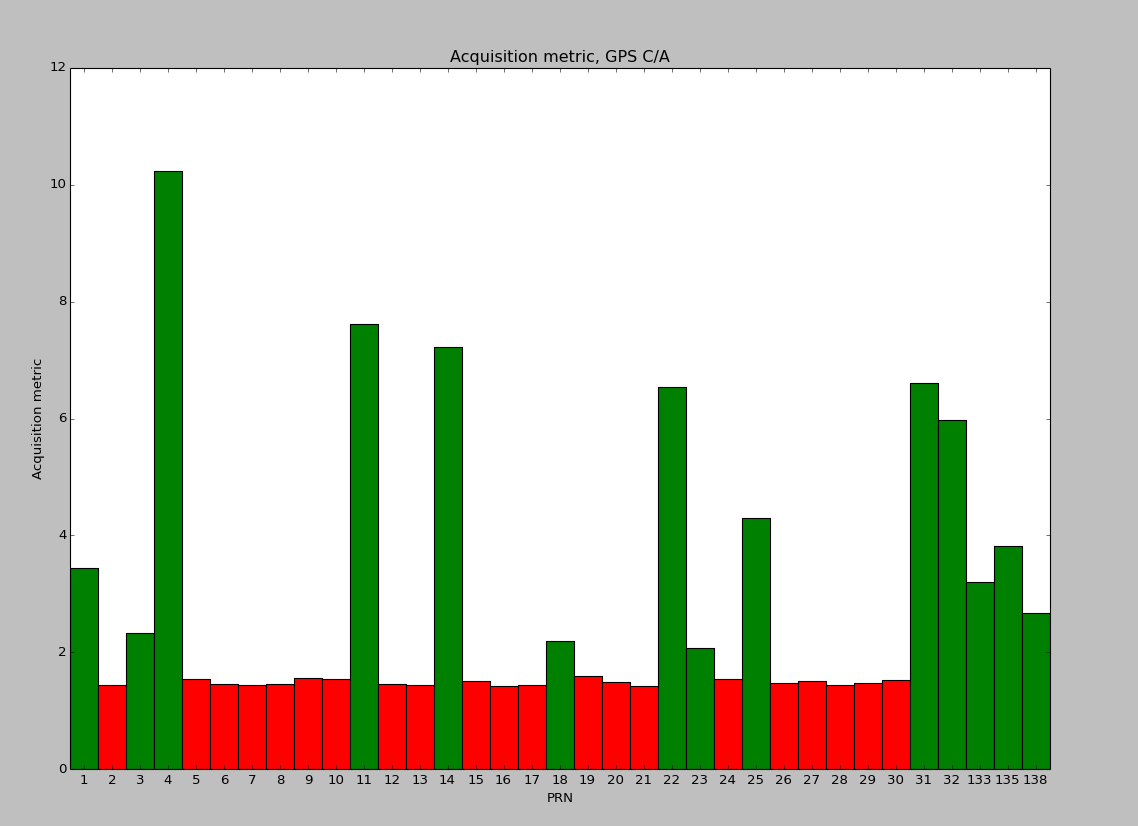Just a quick update on the GNSS Firehose digitizer project. I've decided to get a few systems professionally assembled; they will be similar to this prototype unit:
Here is some sample data, a sky recording taken on May 6 at around 13:38 UTC:
This represents 10.2 seconds of data simultaneously sampled on bands centered at ~1584.8 MHz and ~1227.7 MHz; each channel has a useful bandwidth of about 50 MHz. The format is raw Ethernet packets as written by tcpdump. The packet2wav utility unpacks the various sample streams from these packets and checks timestamps.
To use this file with my software receiver, here's a command to acquire all the GPS L1 C/A signals in view:
$ <gnss-3.dat packet2wav | ./acquire-gps-l1.py /dev/stdin 69984000 -9334875 prn 1 doppler 3200.0 metric 3.45 code_offset 863.2 prn 2 doppler 1800.0 metric 1.45 code_offset 603.4 prn 3 doppler 4200.0 metric 2.33 code_offset 456.6 prn 4 doppler 1000.0 metric 10.23 code_offset 134.4 prn 5 doppler -3600.0 metric 1.54 code_offset 57.2 prn 6 doppler -4800.0 metric 1.46 code_offset 433.3 prn 7 doppler -800.0 metric 1.45 code_offset 222.5 prn 8 doppler 3000.0 metric 1.46 code_offset 488.3 prn 9 doppler 400.0 metric 1.57 code_offset 362.4 prn 10 doppler 3400.0 metric 1.54 code_offset 506.3 prn 11 doppler 1000.0 metric 7.62 code_offset 728.8 prn 12 doppler -400.0 metric 1.46 code_offset 93.4 prn 13 doppler -2600.0 metric 1.44 code_offset 595.4 prn 14 doppler -800.0 metric 7.23 code_offset 558.5 prn 15 doppler -600.0 metric 1.51 code_offset 90.7 prn 16 doppler 0.0 metric 1.43 code_offset 772.2 prn 17 doppler 3200.0 metric 1.44 code_offset 301.7 prn 18 doppler -1200.0 metric 2.20 code_offset 760.5 prn 19 doppler -1600.0 metric 1.59 code_offset 657.4 prn 20 doppler -4400.0 metric 1.50 code_offset 910.4 prn 21 doppler 2200.0 metric 1.42 code_offset 674.6 prn 22 doppler -800.0 metric 6.54 code_offset 923.6 prn 23 doppler 4200.0 metric 2.08 code_offset 94.4 prn 24 doppler 2200.0 metric 1.55 code_offset 406.4 prn 25 doppler 3000.0 metric 4.29 code_offset 513.2 prn 26 doppler 1600.0 metric 1.47 code_offset 628.4 prn 27 doppler 600.0 metric 1.51 code_offset 135.4 prn 28 doppler 200.0 metric 1.45 code_offset 631.4 prn 29 doppler 1600.0 metric 1.47 code_offset 378.4 prn 30 doppler -2800.0 metric 1.52 code_offset 737.5 prn 31 doppler 3000.0 metric 6.61 code_offset 367.1 prn 32 doppler 2600.0 metric 5.98 code_offset 176.8 prn 133 doppler 1600.0 metric 3.20 code_offset 481.3 prn 135 doppler 1400.0 metric 3.82 code_offset 86.7 prn 138 doppler 1400.0 metric 2.67 code_offset 824.9 $
A plot of these acquisition metrics across the various PRNs:
Here's a summary of the visible signals on L1 after acquisition is done across all the GNSS services:
GPS L1 C/A: 1 3 4 11 14 18 22 23 25 31 32 133 135 138 GLONASS L1 C/A: (none found) Galileo E1b: 14 Galileo E1c: 14 BeiDou B1I: 11 14
and on L2:
GPS L2CM: 1 3 25 31 GLONASS L2 C/A: -2 -1 3 5 6 GLONASS L3I: (none found) GLONASS L3Q: (none found) Galileo E5bI: 14 Galileo E5bQ: 14 BeiDou B2I: 11 14
My L1/L2 antenna, an AeroAntenna AT2775-42, doesn't quite cover GLONASS on L1. Occasionally a signal on channels -7 or -6 is strong enough to show up, but no luck for this capture. GLONASS L2 is fine though, as are the newer GLONASS L3 CDMA signals (not present in this capture unfortunately). Of course other signals such as L2CL and P will be acquirable and trackable as well, but they are more difficult to acquire blindly.
Just for fun, here are the raw samples from the L1 channel. Clearly not much can be seen from this, but it can be useful as a quick check. Samples are 2 bits (represented on the output stream as two's-complement 8-bit for processing convenience), alternating I and Q, at 69.984 Msa/s.
$ <gnss-3.dat packet2wav | od -Ad -tx1 | head 0000000 ff 03 03 03 01 ff fd 01 ff 01 03 01 ff 01 03 fd 0000016 01 fd ff fd ff fd ff ff ff fd ff ff ff 03 ff 01 0000032 01 03 01 03 ff 03 03 03 01 ff ff ff ff 03 01 01 0000048 03 01 01 fd fd 01 01 03 01 01 01 01 03 01 01 03 0000064 fd fd fd ff fd 03 fd ff ff 03 01 ff ff fd fd 01 0000080 ff 01 03 ff ff ff 03 03 03 01 ff ff ff ff 01 ff 0000096 fd 01 ff ff 01 01 ff ff ff fd 03 fd ff fd ff fd 0000112 01 01 fd 01 ff fd ff 01 fd ff ff ff 01 01 ff ff 0000128 01 01 01 01 ff 01 03 01 03 ff 01 ff 01 01 01 01 0000144 01 fd fd 01 ff 01 01 ff 01 03 ff 01 01 03 01 01
And the raw samples from channel 2, the downconverter channel looking at L2:
$ <gnss-3.dat packet2wav 2 | od -Ad -tx1 | head 0000000 ff 01 fd 01 01 01 01 ff ff ff fd 01 ff 03 01 03 0000016 03 01 fd 01 fd ff ff 01 ff 03 fd 03 fd ff ff 01 0000032 03 ff 01 fd ff fd 01 01 ff 01 fd 01 01 fd ff ff 0000048 ff 01 03 ff 01 fd 01 ff 01 ff 03 ff ff ff ff ff 0000064 ff ff 01 fd 03 01 03 ff 01 fd ff 01 ff ff fd 01 0000080 ff 01 01 ff 03 01 01 03 03 01 01 ff ff ff 03 ff 0000096 ff ff 01 ff 01 ff 01 01 03 01 01 fd ff fd ff ff 0000112 fd 03 ff 01 ff ff 03 ff 01 ff fd 01 01 fd 01 fd 0000128 01 fd ff ff ff fd fd fd 01 01 01 03 ff 03 01 03 0000144 ff 01 ff 01 01 01 01 ff 03 01 01 ff ff ff ff fd
I plan to add the FPGA and software support for the third RF channel (set to cover L5 by default) over the next few weeks while the boards are being manufactured and assembled. I now have a simple helical antenna suitable for L5, so I should be able to do tri-band experiments.
Pointers to the GitHub repositories containing hardware design and software receiver:


